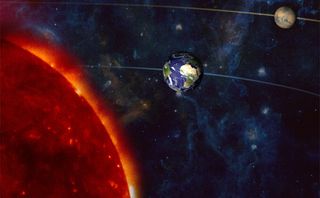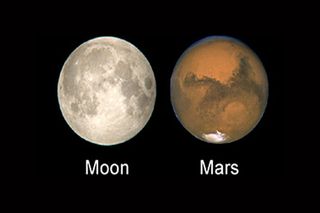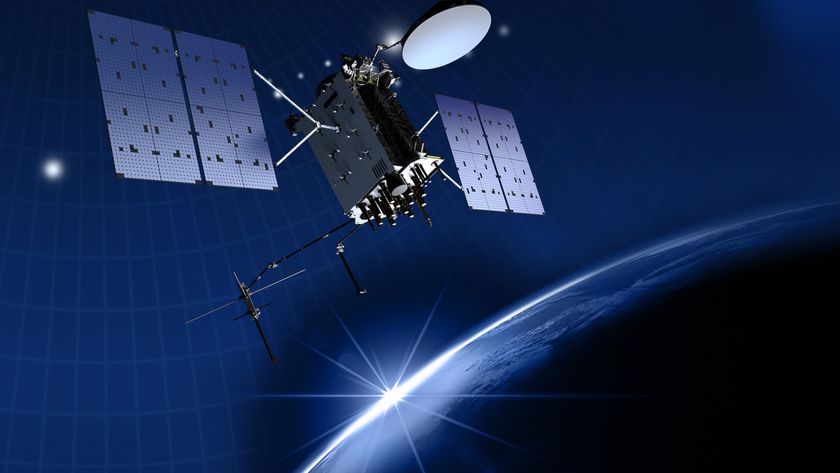Mars Opposition 2020: How to See It and What to Expect
Mars reaches opposition with the sun on Oct. 13, 2020
Get ready to see the Red Planet up close this week: Mars reaches opposition with the sun on Oct. 13, 2020, offering the closest view of the planet until 2035.
Mars and Earth both orbit the sun, but at different distances, and thus, different speeds. Every two years or so, Mars, Earth and the sun form a straight line during the course of their orbits, with Earth in the middle — an event known as opposition.
This fall, opposition will occur on Oct. 13, following the Red Planet’s closest approach to Earth last week, on Oct. 6, when the two planets were separated by just 38.6 million miles (62 million kilometers). Observers in the Northern Hemisphere will have an exceptional view of the Red Planet during opposition this year, as Mars is positioned farther north and higher in the sky, according to Sky & Telescope.
Related: You don't want to miss Mars shining bright this fall

"Indeed, Mars won't be comparably close and well-positioned for northern observers again until it reaches opposition in 2052, making this year's opposition all the more noteworthy," said Gary Seronik, consulting editor for Sky & Telescope magazine.
In addition, Mars recently reached what is called "perihelic opposition" on Aug. 3, 2020. Perihelion refers to the point in Mars' orbit when it's closest to the sun. Therefore, when Mars is closest to the sun, it is even closer to Earth during opposition. Since August, the Red Planet has slowly been moving farther from the sun.
What, exactly, is an opposition?
Mars orbits the sun at a greater distance than Earth. As the distances increase, the orbital period also increases, so Mars takes about 26 months to complete one orbit around the sun. Due to these different orbital speeds, every two years or so, Earth passes between Mars and the sun. This means that Mars and the sun are on directly opposite sides of Earth.
Get the Space.com Newsletter
Breaking space news, the latest updates on rocket launches, skywatching events and more!
Also, because Mars is directly opposite the sun during opposition, Mars rises as the sun sets, and it sets as the sun rises. As a result, the Red Planet shines prominently in our night sky. In fact, during opposition, Mars is at its brightest and near its maximum apparent size in telescopes.
However, since both planets have elliptical orbits, some Earth-Mars encounters are closer than others. The last time Mars aligned with the sun and Earth in 2018, the Red Planet was slightly closer to Earth, at a distance of only 35.8 million miles (57.6 million km) away.
During the Mars opposition in 2003, the Red Planet was even closer, at a distance of only 34.6 million miles (55.8 million kilometers) from Earth. This was the closest the two planets had come to each other in almost 60,000 years, and this record won't be broken until Aug. 28, 2287, according to NASA. However, the Red Planet's next-closest approach will occur in 2035.
In comparison, when Mars is on the other side of the sun and thus at its greatest distance from Earth, it is about 250 million miles (401 million km) away. The average distance between the two planets is roughly 140 million miles (225 million km).
How to see Mars
Throughout most of October, Mars will appear brighter than any other object in its region of the sky, outshining Jupiter and moving up in rank as the fourth-brightest object in Earth's sky after Venus, the moon and the sun.
Astronomers use a scale called magnitude to rate the brightness of celestial objects. During opposition, Mars will reach a peak brightness magnitude of –2.6. The lower the magnitude, the brighter the object, with stars on the threshold of naked-eye visibility classified as sixth magnitude.
The Red Planet will rise earlier and earlier in the weeks following opposition, before the planet gradually begins to fade. By the end of November, Mars will be only a quarter as bright, at a magnitude of –1.1, which is slightly fainter than Sirius, the brightest star in the night sky, according to Sky & Telescope.
While Mars is easily distinguished by its reddish color and visible to the naked-eye during opposition, a high-quality telescope is still required to view its famous surface features in greater detail.
Beware of the Mars Hoax

In 2003, during that year's epic Mars conjunction, a hoax that went viral claimed that Mars would be as big as the moon. Since then, the meme comes up every now and then, usually around September, and it may rear its ugly head again this year.
But don't be fooled — while Mars will shine big and brightly leading up to and during opposition, the Red Planet is only about half the size of Earth. This means that even at its closest approach this summer, it will only be 24.3 arc seconds across when viewed from Earth. In comparison, the angular diameter of the moon is 1,800 arc seconds, which is about 75 times larger.
Editor's note: If you snap an amazing photo of Mars and would like to share it with Space.com for a story or photo gallery, send comments and images to spacephotos@space.com.
Follow Samantha Mathewson @Sam_Ashley13. Follow us @Spacedotcom, Facebook and Google+. Original article on Space.com.
Join our Space Forums to keep talking space on the latest missions, night sky and more! And if you have a news tip, correction or comment, let us know at: community@space.com.

Samantha Mathewson joined Space.com as an intern in the summer of 2016. She received a B.A. in Journalism and Environmental Science at the University of New Haven, in Connecticut. Previously, her work has been published in Nature World News. When not writing or reading about science, Samantha enjoys traveling to new places and taking photos! You can follow her on Twitter @Sam_Ashley13.











